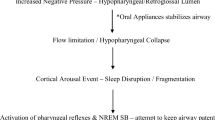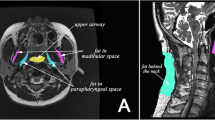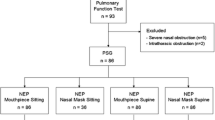Abstract
This study evaluated whether changes in jaw and neck position caused substantial airway resistance (Raw) changes in normal controls and obstructive sleep apnea (OSA) subjects. Subject groups included 12 male nocturnal polysomnographically diagnosed OSA patients and 16 healthy male control subjects. Raw was assessed plethysmographically and measured under the following conditions: neutral head posture with 0/3, 1/3, 2/3, or 3/3 of the subjects maximum forward jaw position; normal jaw (0/3 forward) with fully flexed, extended, right or left rotated head position. Both groups showed a similar significant decrease in Raw upon jaw protrusion. OSA patients showed a significantly higher baseline (normal jaw, neutral head posture). Raw and both subject groups also had a clear increase in their airway resistance with flexion and to a lesser extent with neck rotation and extension. These data document that airway resistance can be significantly influenced by head and jaw positioning with protrusion of the jaw reducing Raw and flexing the neck increasing Raw.
Similar content being viewed by others
References
Rivlin J, Hoffstein V, Kalbfleisch J, et al. Upper airway morphology in patients with idiopathic obstructive sleep apnea. Am Rev Respir Dis 1984;129:355–360
Safar P, Escarraga LA, Chang, F. Upper airway obstruction in the unconscious patient. J Appl Physiol 1959;14:760–764
Powell N, Guilleminault C, Riley R, Smith L. Mandibular advancement and obstructive sleep apnea syndrome. Bull Eur Physiopath Resp 1983;19:607–610
Kuo PC, West RA, Bloomquist DS, McNeil RW. The effect of mandibular osteotomy in 3 patients with hypersomnia and sleep apnea. Oral Surg Oral Med Oral Pathol 1979;48:385–392
Bear SE, Priest JH. Sleep apnea syndrome: correction with surgical advancement of the mandible. J Oral Surg 1980;38:543–549
Robin P. Glossoptosis due to atresia and hypotrophy of the mandible. Am J Dis Child 1934;48:541–547
Cartwright RD, Samelson CF. The effect of a nonsurgical treatment for obstructive sleep apnea. The tongue-retaining device. J Am Med Assoc 1982;248:705–709
Cartwright RD. Predicting response to the tongue retaining device for sleep apnea syndrome. Arch Otolaryngol 1985;111:385–388
Cartwright R, Stefoski D, Caldarelli D, et al. Toward a treatment logic for sleep apnea: the place of the tongue retaining device. Behav Res Ther 1988;26:121–126
Clark GT, Arand D, Chung E, Tong D. The effect of an anterior mandibular positioning appliance on obstructive sleep apnea. Am Rev Respir Dis 1993;147:624–629
Clark GT, Blumenfeld I, Yoffe N, Peled E, Lavie P. A cross-over study comparing the efficacy of continuous positive air pressure (CPAP) with anterior mandibular positioning (AMP) devices on obstructive sleep apnea patients. Chest 1996;109:1477–1483
George PT. A modified functional appliance for treatment of obstructive sleep apnea. J Clin Orthod 1987;11:171–175
George PT. Treatment of snoring and obstructive sleep apnea with a dental device. General Dent 1993;41:294–298
Rider EA. Removable Herbst appliance for treatment of obstructive sleep apnea. J Clin Orthod 1988;12:256–257
Schmidt-Nowara WW, Meade TE, Hays MB. Treatment of snoring and obstructive sleep apnea with a dental orthosis. Chest 1991;99:1378–1385
Masumi S, Nishigawa K, Yan-Go, FL, Williams AJ, Clark GT. Effect of jaw position and posture on forced inspiratory airflow. Chest 1996;109:1484–1489
Coverdale SGM, Read DJC, Woolcock AJ, Schoeffel RE. The importance of suspecting sleep apnea as a common cause of excessive daytime sleepiness: further experience from the diagnosis and management of 19 patients. Aust N Z J Med 1980;10:284–288
Hensley MJ, Read DJC. Intermittent obstruction of the upper airway during sleep causing profound hypoxaemia. A neglected mechanism exacerbating chronic respiratory failure. Aust N Z J Med 1976;6:481–486
Suratt PM, Gal TJ, Hooe DM. Effect of head flexion on airway resistance measured in a body plethysmograph. Br J Dis Chest 1981;75:204–206
Liistro G, Stanescu D, Dooms G, Rodenstein D, Veriter C. Head position modifies upper airway resistance in men. J Appl Physiol 1988;64:1285–1288
Spann RW, Hyatt RE. Factors affecting upper airway resistance in conscious man. J Appl Physiol 1971;31:708–712
Leiter JC, Knuth SL, Bartlett Jr D. Dependence of pharyngeal resistance on genioglossal EMG activity, nasal resistance, and airflow. J Appl Physiol 1992;73:584–590
DuBois AB, Botelho SY, Comroe Jr. JH. A new method for measuring airway resistance in man using a body plethysmograph: values in normal subjects and in patients with respiratory disease. J Clin Invest 1956;35:327–335
Reed WR, Roberts JL, Thach BT. Factors influencing regional patency and configuration of the human infant upper airway. J Appl Physiol 1985;58:635–644
Morikawa S, Safar P, Decarlo J. Influence of the head-jaw position upon upper airway patency. Anesthesiol 1961;22:265–270
Rubinstein I, McClean PA, Boucher R, Zamel N, Fredberg JJ, Hoffstein, V. Effect of mouthpiece, noseclips, and head position on airway area measured by acoustic reflections. J Appl Physiol 1987;63:1469–1474
Shelton Jr., RL, Bosma JF. Maintenance of the pharyngeal airway. J Appl Physiol 1962;17:209–214
Anch AM, Remmers JE, Bunce III H. Supraglottic airway resistance in normal subjects and patients with occlusive sleep apnea. J Appl Physiol 1982;53:1158–1163
Author information
Authors and Affiliations
Corresponding author
Rights and permissions
About this article
Cite this article
Choi, JK., Goldman, M., Koyal, S. et al. Effect of Jaw and Head Position on Airway Resistance in Obstructive Sleep Apnea. Sleep Breath 4, 163–168 (2000). https://doi.org/10.1007/s11325-000-0163-1
Issue Date:
DOI: https://doi.org/10.1007/s11325-000-0163-1




